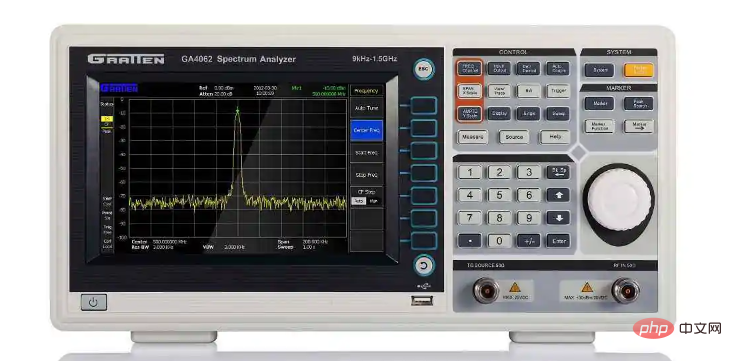Home >Common Problem >What are the main functions of a spectrum analyzer?
What are the main functions of a spectrum analyzer?
- WBOYWBOYWBOYWBOYWBOYWBOYWBOYWBOYWBOYWBOYWBOYWBOYWBOriginal
- 2022-07-13 14:59:3321945browse
The main function of the spectrum analyzer is to measure signal parameters such as signal distortion, modulation degree, spectral purity, frequency stability and intermodulation distortion; the spectrum analyzer is an instrument for studying the spectrum structure of electrical signals and can be used to measure Certain parameters of circuit systems such as amplifiers and filters are a multi-purpose electronic measuring instrument.

The operating environment of this tutorial: Windows 10 system, DELL G3 computer.
What is the main function of a spectrum analyzer?
A spectrum analyzer is an instrument for studying the spectrum structure of electrical signals.
It is used to measure signal parameters such as signal distortion, modulation degree, spectral purity, frequency stability and intermodulation distortion. It can be used to measure certain parameters of circuit systems such as amplifiers and filters. It is A multi-purpose electronic measuring instrument.
It can also be called frequency domain oscilloscope, tracking oscilloscope, analysis oscilloscope, harmonic analyzer, frequency characteristic analyzer or Fourier analyzer, etc. Modern spectrum analyzers can display analysis results in analog or digital form, and can analyze electrical signals in all radio frequency bands from very low frequencies below 1 Hz to sub-millimeter bands. If digital circuits and microprocessors are used inside the instrument to have storage and computing functions, and standard interfaces are configured, it is easy to form an automatic test system.
Spectrum analyzer is an essential means for measuring radio signals and a commonly used tool in the R&D, production, and inspection of electronic products. Therefore, it is widely used and is called the engineer's RF multimeter.

Expand knowledge
The main function of the spectrum analysis system is to display the spectrum characteristics of the input signal in the frequency domain.
Spectrum analyzers generally have two types according to different signal processing methods: real-time spectrum analyzer (Real-Time Spectrum Analyzer) and sweep-tuned spectrum analyzer (Sweep-Tuned Spectrum Analyzer). Real-time frequency analysis The function of the instrument is to display the signal amplitude in the frequency domain at the same instant. Its working principle is to have corresponding filters and detectors for different frequency signals, and then transmit the signals to the The advantage of displaying on display instruments such as CRT or LCD is that it can display the instantaneous response of periodic random waves. The disadvantage is that it is expensive and the performance is limited by the bandwidth range. The number of filters is related to the maximum Switching Time. The most commonly used spectrum analyzer is a sweep-tuned spectrum analyzer. Its basic structure is similar to a superheterodyne receiver. The working principle is that the input signal is directly added to the mixer through an attenuator. It is adjustable. The variable local oscillator generates an oscillation frequency that changes linearly with time through a sweep generator synchronized with the CRT. The intermediate frequency signal (IF) after being mixed and down-converted by the mixer and the input signal is then amplified, filtered and detected and sent to the CRT. The vertical axis of the CRT shows the relationship between signal amplitude and frequency.
Although a lower RBW is helpful in distinguishing and measuring signals of different frequencies, a low RBW will filter out higher frequency signal components, resulting in distortion when the signal is displayed. The distortion value is different from the set RBW Closely related, although a higher RBW is helpful for the detection of wide-band signals, it will increase the noise floor value (Noise Floor), reduce the measurement sensitivity, and easily hinder the detection of low-intensity signals, so an appropriate RBW Width is an important concept for proper use of a spectrum analyzer.
General repairmen do not use it, firstly, its price is higher, and secondly, the operation is more complicated. Need to cooperate with signal generator. But it is very convenient to use to find faults.
For more related knowledge, please visit the FAQ column!
The above is the detailed content of What are the main functions of a spectrum analyzer?. For more information, please follow other related articles on the PHP Chinese website!

